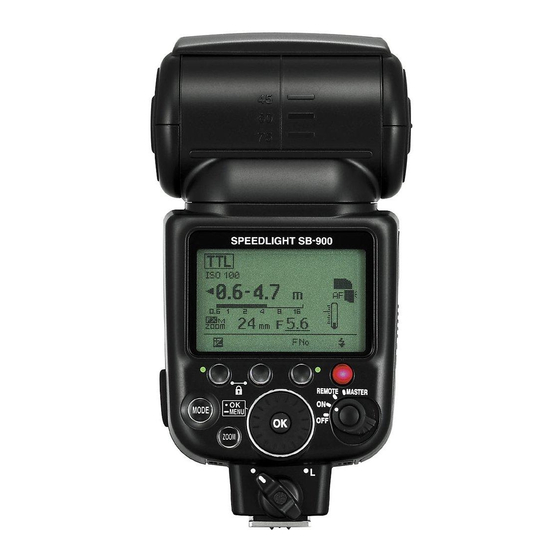Nikon autofocus speedlight SB-900 Посібник - Сторінка 8
Переглянути онлайн або завантажити pdf Посібник для Спалах камери Nikon autofocus speedlight SB-900. Nikon autofocus speedlight SB-900 8 сторінок. Speedlight
Також для Nikon autofocus speedlight SB-900: Технічний паспорт (2 сторінок)

SPEEDLIGHT DVD GLOSSARY
Ambient Light
The natural, available light in a scene. Also known as
existing light.
AF-Assist Illuminator
LED light on the camera that illuminates the subject,
making it possible to focus on the subject even in total
darkness.
Automatic Power Zoom
The zoom head is automatically adjusted according to the
focal length of the lens in use.
Backlighting
The light coming from behind the subject.
Bounce Lighting
Using the bounce feature on a Speedlight, light is
bounced off a reflector, ceiling or wall to soften or diffuse
the light's intensity.
Chiaroscuro
Italian for light-dark, a term in art and photography
for a contrast between light and dark.
CLS
Creative Lighting System – Nikon's Speedlight system.
Feathering
Pan or tilting the light so that its dim edge is used to light
the subject.
Flash Output Level Compensation
Flash compensation used to increase or decrease the
output power of a Nikon Speedlight unit.
Fill-Flash
A technique to brighten dark shadow areas, often used
when the subject is located in the dark shadow.
Fill Light
A light that supplements the key light without changing
its character, used to lighten or open shadows within a
scene.
Front Lighting
Light coming from the direction of the camera toward
the subject.
FP Auto High-Speed Sync
Auto high-speed flash synchronization enables CLS-
compatible cameras and Speedlights to sync at the
camera's highest possible shutter speed. This technique
minimizes depth of field and freezes high-speed subjects.
Flash Synchronization
A means by which a Speedlight is fired at precisely the
moment when the camera's shutter is at its peak opening.
Also referred to as flash sync.
Front Curtain Sync
Also referred to as Normal sync, the flash fires
immediately after the front curtain opens completely.
FV Flash Value Lock
Locks in the appropriate flash exposure for the main
subject, which remains locked whether the aperture,
composition or lens zoom position is changed.
Nikon Inc., 1300 Walt Whitman Road, Melville, NY 11747
www.nikonusa.com 1-800-Nikon-UX
Guide Number (Flash)
Guide numbers proclaim the light output of electronic
flash units. The guide number divided by subject distance
represents the theoretical f-stop for an exposure.
i-TTL Metering
Nikon's Intelligent Through-The-Lens (TTL) flash metering
using monitor pre-flashes for unprecedented levels of
precision and performance.
Key Light
Also called "main" light is the principal source of light on
a subject or a scene.
Master Speedlight Unit
CLS-compatible Speedlight unit, built-in flash or wireless
device (SB-700, SB-900 or SU-800 Wireless Commander)
that works in the Commander mode to send monitor pre-
flash and firing signals to remote Speedlights
Monitor pre-flash
A series of pre-flash firings detected by the camera's TTL
multi-sensor, analyzed for brightness and contrast. Also
used to communicate output values to remote Speedlight
units in multiple wireless lighting.
Quick Wireless Mode
The flash output level ratios of two remote flash unit
groups (A and B) can be easily balanced in quick wireless
control mode.
Rear Curtain Sync
The flash fires just before the rear (second) curtain starts
to close for special effects photography where the blur
appears behind the subject.
Reflectors
Flat devices, typically white, silver, or gold, that redirect
light to soften or fill in areas of a subject or scene.
Remote Speedlight Unit
CLS-compatible Speedlight that can be set to fire as a
wireless remote unit.
Repeating Flash
The Speedlight delivers a stroboscopic effect, firing the
flash continuously at selected rates.
Side Lighting
Light shining on the subject from the side relative to the
camera, often casting long shadows.
Slow Sync Flash
The flash is controlled at a slower shutter speed to obtain
the correct exposure for both the main subject and the
background in low light situations or at night.
TTL
Through the lens. Any metering system - ambient
exposure metering or flash metering - which works
through the lens.
Cover Photo © Joe McNally
SLR-SBINST-34-11/10
